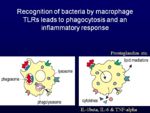Difference between revisions of "Category:Innate Immune System"
| Line 36: | Line 36: | ||
==[[Innate Immunity Cellular Responses]]== | ==[[Innate Immunity Cellular Responses]]== | ||
| − | =Innate Immunity to Viruses | + | =[[Innate Immunity to Viruses]]= |
| − | |||
| − | |||
| − | |||
| − | |||
| − | |||
| − | |||
| − | |||
| − | |||
=Innate Immunity to Bacteria= | =Innate Immunity to Bacteria= | ||
Revision as of 16:00, 13 August 2010
Introduction
The Innate immune system is the body's first barrier of defence to infection. It relies on an older, more generic, and faster acting set of tools than the adaptive system. While the adaptive system is essential for a specific response to infection, it is ultimately the innate system that conquers foreign attackers through means of phagocytosis.
- Non-specific protective mechanisms include such innate factors as:
- Physical barriers
- Skin
- Ciliated mucous membranes
- Commensal organisms
- Humoral factors
- Lysozyme
- Complement
- Interferons
- Cellular mechanisms
- Phagocytosis
- Factors which regulate species specificity
- Membrane receptors for pathogens
- Nutritional requirements
- Temperature
- pH
- Physical barriers
- Mechanisms of innate immunity are always present and generally unchanging
- Adaptive immunity is acquired only on contact with the infectious agent (antigen) and therefore does not function before first contact with the antigen
Actions of the Innate Immune System
Recognition of Microorganisms
Phagocytosis
Tools of Innate Immunity
Innate Immunity Barriers
Humoral Factors of Innate Immune System
Innate Immunity Cellular Responses
Innate Immunity to Viruses
Innate Immunity to Bacteria
The innate response to bacterial infection lies in its first-response role of detection of a foreign organism. By using the above described tools of Pattern-Recognition Receptors (PRRs), the innate response flags up problems while the adaptive response gets itself organized. Once a foreign organism is detected, the innate system responds by engaging in cell warfare via phagocytosis and triggering the inflammatory response. The release of inflammatory cytokines will cause an increase in vasodilation, vascular permeability and an influx of white blood cells. Neutrophils take on their primary role as phagocytes in this phase. In addition, systemic effects of inflammatory cytokines will sustain a rise in core temperature (fever), the release of acute phase proteins from the liver, and bone marrow mobilization as the need for white blood cells production is increased. Acute phase proteins will bind to bacterial cell walls, enhancing neutrophil, macrophage, and complement-initiated phagocytosis.
Interplay of Innate and Adaptive Immunity
Innate Immunity Flashcards
Links
Websites
References
Pages in category "Innate Immune System"
The following 10 pages are in this category, out of 10 total.
